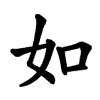Definify.com
Definition 2025
囗
囗
| ||||||
|---|---|---|---|---|---|---|
Translingual
| Stroke order | |||
|---|---|---|---|

| |||
Han character
囗 (radical 31 囗+0, 3 strokes, cangjie input 月一 (BM) or XX月一 (XXBM), four-corner 60000)
- used as a shorthand for some other characters, including 圍 and 國
- Kangxi radical #31, ⼞ (“enclosure”).
Usage notes
This character (囗) is used for enclosures; if a square is used within a character, then the character is instead 口.
References
- KangXi: page 216, character 14
- Dai Kanwa Jiten: character 4675
- Dae Jaweon: page 439, character 15
- Hanyu Da Zidian: volume 1, page 710, character 8
- Unihan data for U+56D7
Chinese
|
simp. and trad. |
囗 | |
|---|---|---|
Pronunciation
- Mandarin
- (Standard Chinese, Beijing)+
- Pinyin:
- Zhuyin: ㄨㄟˊ
- Wade-Giles: wei2
- Gwoyeu Romatzyh: wei
- IPA (key): /u̯eɪ̯³⁵/
- (Standard Chinese, Beijing)+
- Pinyin:
- Zhuyin: ㄍㄨㄛˊ
- Wade-Giles: ko2
- Gwoyeu Romatzyh: gwo
- IPA (key): /ku̯ɔ³⁵/
- (Standard Chinese, Beijing)+
- Cantonese
- (Standard Cantonese, Guangzhou)+
- Jyutping: wai4
- Yale: wàih
- Cantonese Pinyin: wai4
- IPA (key): /wɐi̯²¹/
- (Standard Cantonese, Guangzhou)+
- Hakka
- (Sixian, incl. Miaoli and Meinong)
- Pha̍k-fa-sṳ: vì
- Hakka Romanization System: viˇ
- Hagfa Pinyim: vi2
- IPA: /vi¹¹/
- (Sixian, incl. Miaoli and Meinong)
- Min Nan
- (Hokkien)
- Pe̍h-ōe-jī: ûi / kok
- Tâi-lô: uî / kok
- Phofsit Daibuun: uii, kog
- IPA (Xiamen): /ui²⁴/, /kɔk̚³²/
- IPA (Quanzhou): /ui²⁴/, /kɔk̚⁵/
- IPA (Zhangzhou): /ui¹³/, /kɔk̚³²/
- IPA (Taipei): /ui²⁴/, /kɔk̚³²/
- IPA (Kaohsiung): /ui²³/, /kɔk̚³²/
- (Hokkien)
| Rime | |
|---|---|
| Character | 囗 |
| Reading # | 1/1 |
| Initial (聲) | 云 (35) |
| Final (韻) | 微 (21) |
| Tone (調) | Level (Ø) |
| Openness (開合) | Closed |
| Division (等) | III |
| Fanqie | 雨非切 |
| Reconstructions | |
| Zhengzhang Shangfang |
/ɦʉi/ |
| Pan Wuyun |
/ɦʷɨi/ |
| Shao Rongfen |
/ɣiuəi/ |
| Edwin Pulleyblank |
/ɦuj/ |
| Li Rong |
/ɣiuəi/ |
| Wang Li |
/ɣĭwəi/ |
| Bernard Karlgren |
/we̯i/ |
| Expected Mandarin Reflex |
wéi |
| Zhengzhang system (2003) | |
|---|---|
| Character | 囗 |
| Reading # | 1/1 |
| No. | 12808 |
| Phonetic component |
囗 |
| Rime group |
微 |
| Rime subdivision |
1 |
| Corresponding MC rime |
幃 |
| Old Chinese |
/*ɢʷɯl/ |
Definitions
囗
References
Japanese
Kanji
囗
- This term needs a translation to English. Please help out and add a translation, then remove the text
{{rfdef}}.



